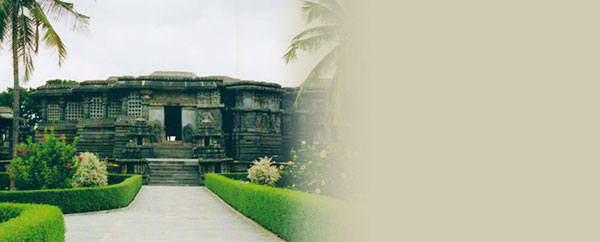Hoysaleswara Temple (Karnataka)
The interior of the temple is quite plain
except for the lathe turned pillars that
run in rows between the north and south
entrances.
Hoysaleswara Temple (Karnataka) Hindu Temples

Hoysaleswara temple is a temple dedicated to Hindu God Shiva. It was built in Halebidu (in modern Karnataka state) during the Hoysala Empire rule in the 12th century by King Vishnuvardhana. The construction was completed in 1121 CE. During the early 14th century, Halebidu was the sacked and looted by Muslim invaders from northern India and the temple fell into a state of ruin and neglect. Previously known as Dorasamudra or Dwarasamudra, Halebidu is 16 km from Belur, 31 km from Hassan and 149 km from Mysore, in the state of Karnataka, India.
He temple is a simple dvikuta vimana (two shrined), one for "Hoysaleswara" and the other for "Shantaleswara" (after Shantala Devi, queen of king Vishnuvardhana) and is built with chloritic chist (Soapstone, also known as potstone). The temple complex as a whole is elevated on a jagati (platform), a feature that became popular in contemporary Hoysala designs.
The two shrines which are adjoining, face east and each have a mantapa (hall) in front. The two mantapas are connected giving a large and imposing view of the hall. Individually, each shrine is smaller than the one at the Chennakesava Temple at Belur and contains a simple linga, the universal symbol of Shiva. The plan of the inside of the temple is simple but the exterior looks different because of the introduction of many projections and recesses in the walls.
The towers of the shrines that are missing must have followed the star shape of the shrine, just as in many existing well-preserved towers in other Hoysala temples. The superstructure of the vestibule (which connects the shrine to the mantapa), called sukanasi, and the row of decorated miniature roofs above the eaves of the hall are all missing.The temple was built at a height that provided the architects sufficient horizontal and vertical space to depict large and small sculptures.
The overall effect of the vertical and horizontal lines, the play of the outline, the effect of light and shade and the plan of the projections and recesses all amounts to a "marvellous exhibition of human labor to be found even in the patient east and surpasses anything in Gothic art".
The outer walls of these temples contain an intricate array of stone sculptures. The temple of Halebidu, has been described as an "outstanding example of Hindu architecture" and as the "supreme climax of Indian architecture".The temple has four porches for entry and the one normally used by visitors as main entry today is actually a lateral entrance (north). There is one entry on the south side and two on the east side, facing two large detached open pavilions whose ceiling is supported by lathe turned pillars. All entry porches have miniature shrines as flanking. In addition there is a sanctuary for the Sun God Surya, whose image stands 7 ft (2.1 m) tall. The pavilions enshrine large images of Nandi, the bull, an attendant of Shiva.
The pavilions share the same jagati as the main temple. As in the Chennakesava temple, this temple originally had an open mantapa to which, outer walls with pierced window screens made with the same material were erected, making the mantapa a closed one. The window screens are devoid of any art work.
The interior of the temple is quite plain except for the lathe turned pillars that run in rows between the north and south entrances. The four pillars in front of each shrine are the most ornate and the only ones that have madanika sculptures in their pillar brackets.There are no other madanikas in the temple.
Other links
Hindu Temples in India
temples
Karnataka